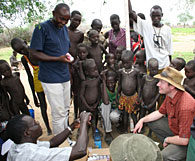Children in the United States may not give grape-flavored cough syrup another thought, but in Eastern Equatoria, Sudan, children look forward to their yearly dose of an antibiotic that tastes like bananas. The medicine, azithromycin, is one part of a strategy designed to prevent blinding trachoma, a bacterial eye disease and leading cause of preventable blindness in the world.
A recent program evaluation by the Carter Center Trachoma Control Program showed that simple measures applied at the community level can nearly eliminate the devastating disease in one of the most neglected regions of the world.
The evaluation results, published in the August 2006 issue of the medical journal The Lancet, centered around the SAFE strategy, the four-pronged approach to controlling trachoma endorsed by the World Health Organization. After three years of intervention using the SAFE strategy in communities in southern Sudan, prevalence of active trachoma and unclean faces was reduced by up to 92 percent and 87 percent, respectively. The program was implemented with support of the Lions Clubs International Foundation in four districts with a combined population of almost 250,000 people.
The SAFE strategy refers to surgery, antibiotics, facial cleanliness, and environmental improvement.
"The evaluation data provide hope that if the strategy can be implemented with such success in southern Sudan, an area with limited resources, little infrastructure, and difficulties in access and insecurity, the strategy can be used to effectively wipe out the disease in all countries where it is found," said Dr. Paul Emerson, technical director of the Carter Center Trachoma Control Program and co-author of the Lancet paper.
Caused by bacteria, trachoma is prevalent in poor, rural communities that lack access to basic hygiene, clean water, and adequate sanitation. The disease is easily spread throughout a community via contact with dirty clothes, hands, and flies that are attracted to eyes.
"These disease factors have been aggravated by the prolonged civil conflict in Sudan. In fact, the trachoma situation in southern Sudan is dire, with one of the highest prevalence rates of blinding trachoma in the world," said Dr. Jeremiah Ngondi, co-author of the paper and Carter Center consultant.
The path to blindness from trachoma is slow and painful as repeated infections cause the eyelid to scar and turn inward allowing the eyelashes to scrape against the cornea. If left untreated, eyelashes constantly scratch the surface of the cornea leading to scarring and irreversible blindness. For millions of people tortured by the end stages of the preventable disease, the world permanently fades from view, one painful blink at a time. Young children who rub their eyes with unclean hands and whose faces are constantly wiped by their mothers' skirts, bear the heaviest burden of active trachoma infections and are the main source of infection for other people.
The study raises opportunity for future research on the collateral health benefits that the SAFE strategy can provide for children in trachoma-endemic areas of southern Sudan and elsewhere around the world.
"Just imagine how useful it is for people to have a yearly dose of a systemic antibiotic, plus hygiene promotion, plus access to water and sanitation, and imagine what effect that also is having on diarrheal diseases, infection with worms, pneumonia, and other communicable diseases. We can have a powerful effect on health and development through the vehicle of trachoma control," said Dr. Emerson.
Note: The Lancet article's authors include Carter Center Consultant Dr. Jeremiah Ngondi, and Dr. Paul Emerson, former technical director of the Carter Center's Trachoma Control Program. The University of Cambridge partnered with the Center on this article.

Carter Center Photo: Paul Emerson
A Sudanese girl in Eastern Equatoria State takes a dose of banana-flavored azithromycin to protect herself from the bacteria that causes trachoma. Young children carry the highest burden of active trachoma infection and annual mass distribution of antibiotics is recommended for communities where more than 10 percent of young children suffer from the disease.

Carter Center Photo
Sudanese children watch as Dr. Paul Emerson, technical director of the Carter Center Trachoma Control Program and local health care workers mix doses of the antibiotic azythromycin. A recent evaluation has shown that communities in southern Sudan receiving mass antibiotic distribution in conjunction with other interventions in the SAFE strategy have benefited from lower incidences of trachoma and trichiasis.
Click here to learn more about the Carter Center's trachoma control efforts in Sudan >>
 ELIMINATING BLINDNESS THE SAFE WAY:
ELIMINATING BLINDNESS THE SAFE WAY:
Read The Lancet: Full Articles and Editorial (Note - online signup required to read articles.)
"...the trachoma situation in southern Sudan is dire, with one of the highest prevalence rates of blinding trachoma in the world."
– Dr. Jeremiah Ngondi, co-author of the paper and Carter Center consultant.
Please sign up below for important news about the work of The Carter Center and special event invitations.